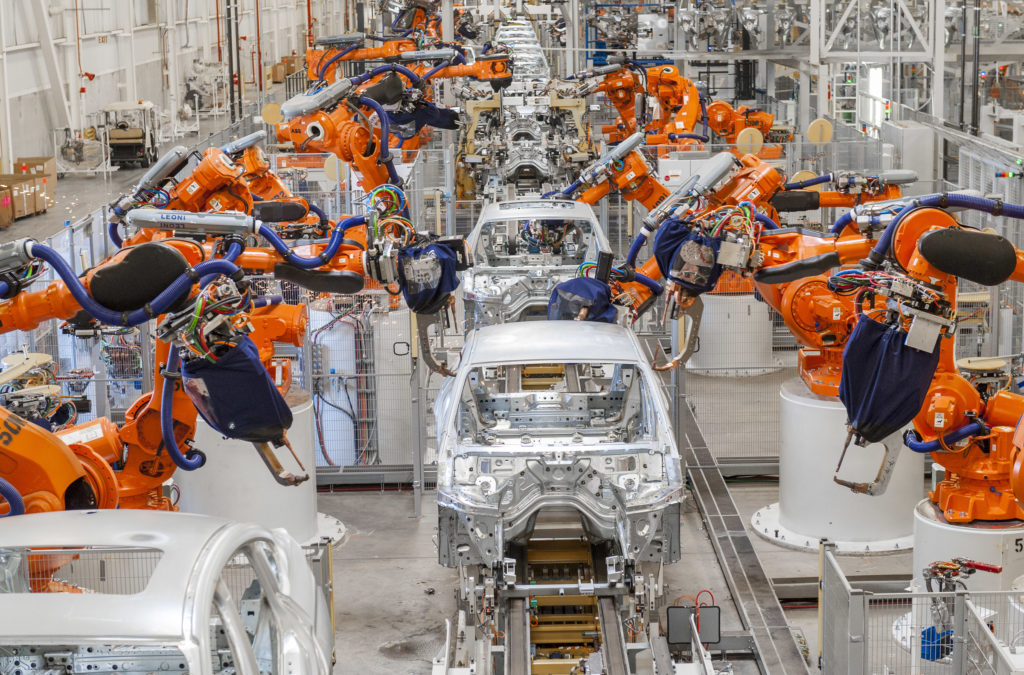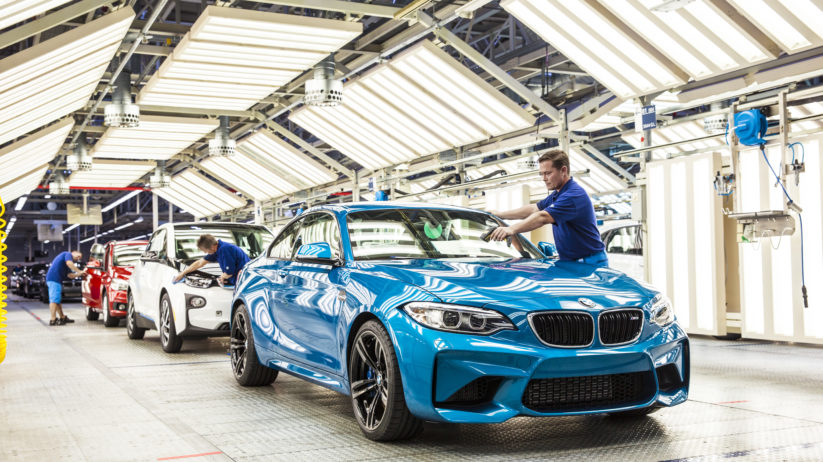To date, the approximate number of shuttered, abandoned, or otherwise divested factories, plants, and manufacturing facilities that General Motors has had a hand in is slightly beneath the triple-digit threshold. Just over a dozen more have been sold after being used for cooperative purposes, while roughly 70 or so sites remain operating. Those figures are going to continue trending negatively next year by a strong margin, thanks to GM’s latest restructuring initiative, which includes plans to idle five more factories as the automaker shifts its focus away from conventional sedans and passenger cars and into crossovers and SUVs.
There’s not much point in juxtaposing comparatively small and independent BMW to gargantuan GM in terms of scope and overall footprint, but while GM is closing plants and cutting its workforce, BMW has added SAV and SAC X model alternatives numbering one through seven to its lineup, meaning the automaker literally offers something for everyone.
The GM brand portfolio and respective model lineups aren’t particularly relevant here, but it is safe to say that, aside from a few special models, not many people lust after owning a GM product in the precise way they do for a variety of other models by other makes. BMW is also expanding production operations around the globe, with new facilities being discussed and built, while existing ones are being expanded and updated almost continuously.

It’s pretty easy to explain all of that growth and expansion when looking at BMW’s financials and how they’ve experienced a similarly positive trajectory, but one still has to wonder how what was once a small automaker was able to rise to prominence as one of the most recognizable and valuable brands on earth, with tens of millions of cars produced along the way.
As an automaker, BMW’s specific core competencies are numerous, and include a focus on an engaging driving experience, small but powerful engines, and the willing use of technology—all rolled into attractive yet practical vehicles. As a multinational firm, however, BMW’s core competency is its manufacturing and logistics prowess. Although many other automakers, specifically competitors in Germany and Japan, can brag about their own production operations and facilities, it is no secret that those of BMW remain the envy of many making their livelihood elsewhere.
Take a tour of almost any BMW production facility worldwide that’s actually churning out vehicles, as opposed to engines or the like, and you’ll be amazed at the variety of the models coming down the line. The focus of Spartanburg has long been models like the X5, but today the production menu includes the X3, X4, X6, and X7. The same applies to the sites in Leipzig, Regensburg, Garching, and Munich, Germany; although each facility may have its speciality, with Leipzig currently building the M2, i3, and i8, and Regensburg traditionally building the M3, the plants were never intended to be limited to making just one model, and the production schedules include various others like the 3 Series, X1, X2, 2 Series, and many more.
And then there is the U.S., the country which witnessed the birth of the assembly line and standardized production, only to have the concepts improved and essentially perfected a matter of decades later by a Japan still recovering from the horrors of WW-II. Today, the U.S. remains one of the most powerful countries in terms of manufacturing, but has long since given up hopes of competing with Europe or Japan—and now Korea—in terms of the elusive combination that includes quality, longevity, desirability, and value, both initial and long-term residual, in consumer production automobiles.

For those of us keeping track, GM has restructured itself no fewer than three times in the previous four decades. The first time, under the guidance of CEO Roger B. Smith, whom some might remember from Michael Moore’s breakout documentary Roger & Me, it is speculated that GM spent enough money to purchase Japanese competitors Toyota and Nissan outright in a botched effort to modernize, computerizem and automate production, a plan which even included the purchase of Ross Perot’s Electronic Data Systems for $2,550,000,000 in 1984 as just one small element in the grander scheme.
Another program, referred to as GM10, gave us the W-body; it preceded the reorganization and modernization effort in 1982, and was intended to replace all current models with a brand-new lineup, all of which would of course use nearly identical underpinnings. This venture proved to be a failure as well, with various different models from the various GM brands appearing similar, thus cannibalizing sales, but with different underpinnings and drivetrains that kept production costs high thanks to a lack of component interchangeability.
Few remember an even earlier joint project with Fujitsu in an effort to manufacture robotics for vehicle production lines, which came to fruition in the form of the robots painting themselves or welding car doors permanently shut.
In all, it is estimated that GM blew through more than $90,000,000,000 during the decade of the 1980s, and by 1989, was losing roughly $2,000 per vehicle manufactured. (The urban blight that has taken hold in once prosperous communities across Michigan and elsewhere in the rust belt is another story altogether.)
The good economic times were largely on a roll for GM after the early 1990s, through the early-2000s recession, and just before the Great Recession, which many agree began with the stock market peaking in September of 2007. What happened next is still fresh in the memories of many Americans, with GM eventually receiving over $51,000,000,000 in the form of Troubled Assets Relief Program (TARP) funds from the treasury. The bailout, as it has been colloquialized, lasted just under five years, and was unwound by December of 2013 with a resulting $11,300,000,000 loss.
There was also the Chapter 11 bankruptcy filing and reorganization, which can effectively be summarized with the following numbers: a reduction in the number of auto brands from thirteen to eight, the elimination of 900 dealerships nationwide, the shuttering of thirteen plants, and a trimming of the workforce by approximately 22,500 employees.

Now, not even five years removed from the American taxpayer coming to the rescue of GM by proxy, and during some of the best economic times in recent memory, the automaker has once again found itself caught off guard. Years of low gas prices drove strong full-size SUV and truck sales, but never turned the tide of the trend toward crossovers and other, smaller upright cars. Ford is grappling with the same issues, and shocked the world earlier this year by choosing to eliminate most conventional passenger cars from the lineup going forward. Somehow, though, with Ford, the dramatic change in course is not expected to create carnage in the form of shuttered plants and lost jobs.
So what’s the problem with GM? For a company that once led the auto industry and even the world, by some accounts, over the past four decades, GM has become absolutely terrible at the one thing it needs to be at least competent at to survive: building cars. Today, GM still adheres to the old-fashioned, expensive, and outdated practice of dedicating entire manufacturing plants to single models, or a number of similar models using what are likely identical platforms. These facilities have tooling and employees that are both oriented with a narrow scope—and now, with the conventional mid-size sedan suddenly seeming as passé as the nuclear family itself, find themselves lacking in purpose and future use.

Making stylish, desirable, and well-built cars aside, GM remains hamstrung by an ancient decision-making apparatus, a massive unfunded pension liability, untold labor-union obligations, and political gamesmanship which has translated to favorable tax legislation moving factories from urban centers into suburban complexes. And before someone labels me a BMW brand loyalist or a hater of American makes, the Corvette happens to be one of my favorite cars, thanks to considerable seat time in a handful of contemporary models, and there being no replacement for seven liters of American displacement at full tilt; the performance-per-dollar ratio of a C6-generation Z06 is also among the best of any car on the market.
But BMW isn’t content with sitting idly by, either. While some have harshly criticized the company’s move to modular platforms which can be motivated by a variety of different propulsion systems including electric, gasoline, or diesel, the move is a smart one in the long term, because regardless of what the future standard is, the automaker will have something to sell—not only something to sell, but vehicles that have long been in the pipeline, as opposed to some kind of incomplete reactionary response. Another perspective is a quite a bit more positive in its view, taking into account the future flexibility this allows the automaker, thanks to a standardized approach that few others are pursuing.
Can GM save itself? We may never know, as the automaker is likely to be continued to be propped up via tax breaks and other corporate welfare in an attempt to save jobs and stave off the inevitable. Nonetheless, a good first step in the right direction would be a return to form in terms of manufacturing, with the BMW blueprint as the game plan. —Alex Tock
[Photos courtesy BMW AG, General Motors Company.]





















